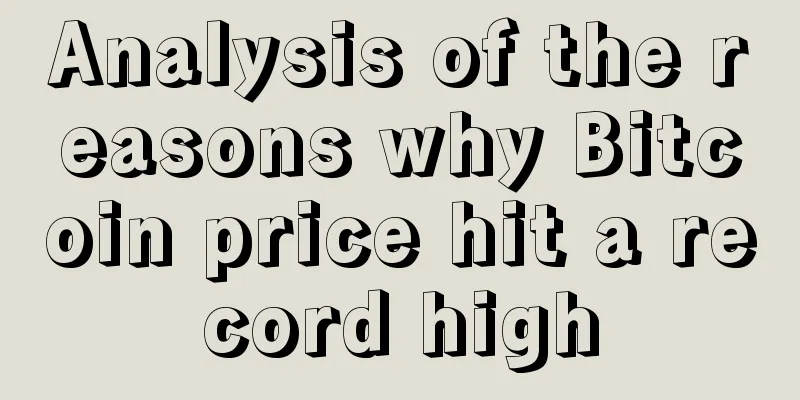Analysis of the reasons why Bitcoin price hit a record high

On Tuesday, the price of Bitcoin reached an intraday high of $69,325[1], surpassing the previous high of $69,000 in USD terms from November 10, 2021 (Chart 1). [2] A few weeks ago, the price of Bitcoin reached all-time highs in other major currencies such as the euro, yen and yuan. Since hitting a cycle low of $15,600 on November 21, 2022, the price of Bitcoin has increased by approximately 330% in USD terms. In addition, as the number of coins in circulation has gradually increased over time, the market capitalization of Bitcoin has increased slightly (+340%) over the same period (November 21, 2022 to date). [3] Chart 1: Bitcoin price hits all-time high Why did Bitcoin prices rebound so quickly? Grayscale Research believes that the recent price increase is directly caused by the demand for spot Bitcoin ETFs listed in the US market. Since their launch on January 11, these products have accumulated nearly $8 billion in net inflows, a figure that far exceeds new issuance. We believe that the imbalance between the growth of ETF demand and the limited new supply of Bitcoin may have led to the rise in Bitcoin prices. While spot Bitcoin ETFs offer a new product structure for cryptocurrency investing in the U.S., marginal demand for Bitcoin ultimately reflects investor interest in Bitcoin as an alternative monetary medium and decentralized computing network. We believe that Bitcoin is a macro asset that can compete with the U.S. dollar and physical gold, two traditional “store of value” assets. The Federal Reserve has indicated that it may cut interest rates this year, and neither U.S. political party seems focused on controlling large peacetime budget deficits. Both falling real interest rates and rising public sector debt could weigh on the value of the dollar and support competing assets, including Bitcoin. In addition, Bitcoin may have an advantage over physical gold for some investors because it is easily portable: Bitcoin can be used anywhere in the world as long as the holder has access to the internet and a private key. We believe that the growth in demand for Bitcoin is mainly coming from investors concerned about the medium-term outlook for the U.S. dollar and seeking alternative “store of value” assets. Notably, the price of physical gold in U.S. dollar terms also hit a new high on Tuesday. Additionally, technological advances have expanded the potential use cases of the Bitcoin network over time. Ordinals inscription began in December 2022 as a way to inscribe non-fungible tokens (NFTs) onto the Bitcoin network and has rapidly grown to become one of the largest NFT networks by volume (Exhibit 2). The emergence of Ordinals has not only encouraged new users to try Bitcoin, but has also spurred new innovation among those who see the potential for other types of use cases, such as trustless Bitcoin-collateralized stablecoin loans and greater Bitcoin usage in decentralized applications. Given rising transaction fees on the main chain, multiple Layer 2 projects have begun development on Bitcoin to improve scalability and use cases. There is evidence of increasing adoption: since the third quarter of 2023, the total value locked has increased from $1.6 billion to $2.7 billion, a 15-fold increase in just a few months. [4] Chart 2: Bitcoin NFTs are growing in popularity Various market indicators suggest that active cryptocurrency traders are currently holding fairly long positions. Funding rates, a measure of the cost of trading leverage, have risen to the higher end of their recent range (Chart 3), but remain below the highs of the previous cycle. Futures open interest has similarly risen to its highest level since the fourth quarter of 2021. Finally, an increase in Google searches for Coinbase, a popular retail trading platform, may also indicate a return of retail traders. Crypto options markets are pricing in increased downside risk: higher implied volatility and negative skewness (i.e., put options are priced higher than call options).[5] Chart 3: Open Interest Indicators Show Active Traders Are Long While Bitcoin has broken through its previous all-time high, most other cryptocurrencies have not. Ethereum, for example, is still down 21% from its November 2021 all-time high (based on closing prices). For the rest of the assets in our cryptocurrency industry framework (excluding Bitcoin and Ethereum), token prices are still around 70% lower than in November 2021. The 2020-2022 cryptocurrency cycle reminds us that crypto market declines can be severe: Bitcoin’s price fell 77% from peak to trough. [6] While investing in Bitcoin has delivered solid returns over the medium term, [7] the asset has also experienced significant drawdowns and volatility. Bitcoin is a high-risk, high-return potential asset with a low correlation to equities. As such, it can be a useful component of a diversified portfolio for some investors. As discussed in our latest monthly update, if the macro market backdrop remains favorable, we may see further gains in token valuations in the coming months. In contrast, a less favorable macro outlook—such as Fed rate hikes and/or a recession—could dampen cryptocurrency valuations. |
<<: About ORDI's investment journey
>>: How is this crypto bull run different from the previous cycle?
Recommend
Can you get married?
Can you get married? We often say that two people...
Rootstock launches test network Bitcoin welcomes smart contracts
Recently, the Rootstock Bitcoin private test netw...
What kind of faces make two people look like a couple?
What kind of faces make two people look like a co...
Judging a person's character and fortune from his tongue
From the perspective of physiognomy, the tongue i...
How to maximize the benefits of Filecoin mining? Miners need to know
IPFS and Filecoin mining have always attracted mu...
What is the emotional line?
The love line occupies the highest position among...
What does a mole on the left shoulder mean? A woman with a mole on her left shoulder
Everyone has moles on their body, and they are di...
What does it mean when a woman has small eyes?
In life, women generally like big eyes, because t...
What does the success line of the super rich look like?
In today's society, money is omnipotent, and ...
The mysterious secret of Yuanhai Ziping
"Yuanhai Ziping" was compiled by Xu Das...
Palmistry that indicates easy extra income
Fortune is something that almost everyone pursues...
Is it good for people to have a triangle pattern on their lifeline?
As the saying goes, knowing your destiny brings y...
Decentralized emergency response CELL411 receives angel investment
Decentralized emergency response application CELL...
4 signs that a man's face is unreliable and you should never marry him
No matter whether you are a man or a woman, young...
Two major Japanese financial institutions join the blockchain war: Mizuho Financial Group joins hands with Cognizant
Editor's note: Blockchain is gaining momentum...









